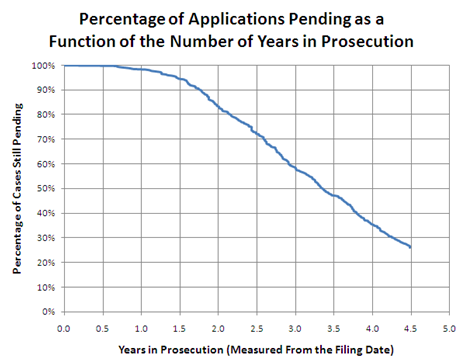This morning I created a dataset of prosecution information for 462 randomly selected utility patent applications filed in December 2004 and January 2005 to get a sense of where those applications stand after 4 ½ years of prosecution. Overall, 48% of the applications have issued as patents; 26% have been abandoned; and 26% are still pending. (Note – I excluded the 12% of cases from my sample that were never published as applications because data is not available for most of them).
Table 1 below shows the detailed status for each case as provided by the USPTO’s PAIR system. All but two of the pending cases have received at least an initial examination. The two still-unexamined cases are both software-related applications.
|
High-Level Status |
Status |
Percent of Cases |
|
Patented |
Patented Case |
47.8% |
|
Abandoned |
Abandoned — Failure to Respond to an Office Action |
25.2% |
|
Abandoned |
Abandoned — Failure to Pay Issue Fee |
0.7% |
|
Abandoned |
Expressly Abandoned — During Examination |
0.2% |
|
Pending |
Non Final Action Mailed |
8.9% |
|
Pending |
Final Rejection Mailed |
6.4% |
|
Pending |
Response to Non-Final Office Action Entered and Forwarded to Examiner |
5.0% |
|
Pending |
On Appeal — Awaiting Decision by the Board of Appeals |
1.0% |
|
Pending |
Notice of Allowance Mailed — Application Received in Office of Publications |
1.0% |
|
Pending |
Notice of Appeal Filed |
0.7% |
|
Pending |
Publications — Issue Fee Payment Verified |
0.5% |
|
Pending |
Examiner’s Answer to Appeal Brief Mailed |
0.5% |
|
Pending |
Docketed New Case – Ready for Examination |
0.5% |
|
Pending |
Appeal Awaiting BPAI Docketing |
0.5% |
|
Pending |
Withdrawn Abandonment awaiting examiner action |
0.2% |
|
Pending |
Response after Final Action Forwarded to Examiner |
0.2% |
|
Pending |
Appeal Brief (or Supplemental Brief) Entered and Forwarded to Examiner |
0.2% |
|
Pending |
Advisory Action Mailed |
0.2% |
|
Table 1 |
An often frustrating aspect of application pendency is that abandoned cases can be kept alive by filing a continuation application. Of those cases that have been either patented or abandoned, 25% have one or more descendents in the form continuation or CIP applications. (I have not determined whether those continuations are themselves still pending.)
Of the cases already completed (no longer pending), the median patent took 2.6 years to issue while the median abandonment did not occur until 3.1 years into prosecution. Along this line, the longer a case was pending, the greater the likelihood that the case was abandoned. Thus, 71% of cases that were pending for fewer than three years were allowed while only 29% of cases that were pending for three to four and a half years were allowed.
The chart below shows the percentage of applications pending as a function of the number of years in prosecution. Although the average time in prosecution for this cohort cannot be calculated yet (because so many cases are still pending), the median time in prosecution – as seen in the chart – is 3.3 years.

The patent office examination corps is divided into various technology centers. In my sample, TC 2800 (Semiconductors, Electrical and Optical Systems and Components) had allowed the highest percentage of cases (70%) and had the lowest rate of applications still-pending after 4 ½ years (3%). TC 1600 (Biotechnology and Organic Chemistry) has the highest abandonment rate (36%) while TC 2600 has the highest percentage of cases still pending (48%).